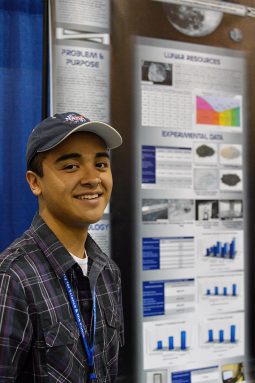Building with moon rocks
Working on the moon with lunar soil and grit could prove easier, more efficient and less costly than using earthly materials
By Sid Perkins

Astronauts will likely colonize the moon one day. Because it costs thousands of dollars to lift a pound of material off of Earth and into orbit, it should prove cheaper to build moon structures from materials already there. And new research by a Georgia teen suggests that concrete made from moon rocks and soil would be stronger than ordinary concrete.
That means a building made from this “lunarcrete” could require less material and be lighter weight. It could also cost less than previous estimates of structures built from moon materials, says the teen.
Concrete is a relatively simple material, made of two parts. One is sand or tiny bits of ground-up rock. The second is a cement that not only fills the space between the grains but also binds them. Usually, construction crews blend the cement in a powder form with other tiny, rocklike ingredients. Then the crew mixes in water. When wet, the cement turns into a mudlike sludge that hardens to hold the gritty bits together.
Sergio Parra, a 17-year-old junior at Mill Creek High School in Hoschton, tested the strengths of several types of concrete. For some of his tests, Parra mixed earthly materials: sand, water and a type of binder known as Portland cement. This cement — sort of a glue — contains finely ground limestone (calcium carbonate). It also includes calcium sulfate, a substance that helps control how quickly the concrete hardens.
For a second set of tests, the teen worked with water and simulated moon materials. These included cement made of calcium oxide and aluminum oxide. Both substances can be easily extracted from lunar soil.
After the ingredients in each soupy mix were stirred together, Parra let them sit and harden into small rocklike bricks. Each was 2 inches (5 centimeters) wide by 1 inch high and 1 inch deep.
Blocks made from the normal concrete could withstand a pressure of 1,626 pounds per square inch (about 114.3 kilograms per square centimeter). But lunarcrete could withstand about 65 percent more pressure — 2,676 pounds per square inch.
Parra presented his results May 13 in Phoenix, Ariz., at the Intel International Science and Engineering Fair. The Society for Science & the Public, which created the fair in 1950, still runs the competition. (SSP also publishes Science News for Kids.)
The new data indicate lunarcrete structures could support more weight than concrete structures. Or, says Parra, lunarcrete buildings could use less material to support the same weight or pressures as concrete. This second option is especially attractive, says Parra. The reason? It would require less water. Even though colonists will be able to create water from hydrogen and oxygen extracted from lunar rocks, that water will be precious. The less water used in construction, the more that colonists will have for drinking, growing food and other essentials.
Because lunar gravity is only one-sixth that at Earth’s surface, colonists on the moon could build very tall structures. In fact, Parra suspects, they will likely build short, light structures and then cover their roofs with lunar soil. That should help protect the moon’s inhabitants from small meteorites or solar flares. It should also help keep temperatures inside their dwellings more stable, he notes.
Power Words
engineer A person who is trained to use math and science to solve practical problems.
calcium carbonate The main chemical compound in limestone, a rock made from the tiny shells of ancient marine organisms. Its formula is CaCO3 (meaning it contains one calcium atom, one carbon atom and three oxygen atoms).
cement A finely ground material used to bind sand or bits of ground rock together in concrete. Cement typically starts out as a powder. But once wet, it becomes a mudlike sludge that hardens as it dries.
concrete A simple, two-part building material. One part is made of sand or ground-up bits of rock. The other is made of cement, which hardens and helps bind the grains of material together.
gravity The force of gravitational attraction at a planet or moon’s surface. The more massive an object is, the stronger its attraction.
lunarcrete A version of concrete that’s made from raw materials available on the moon (not shipped there from Earth).







